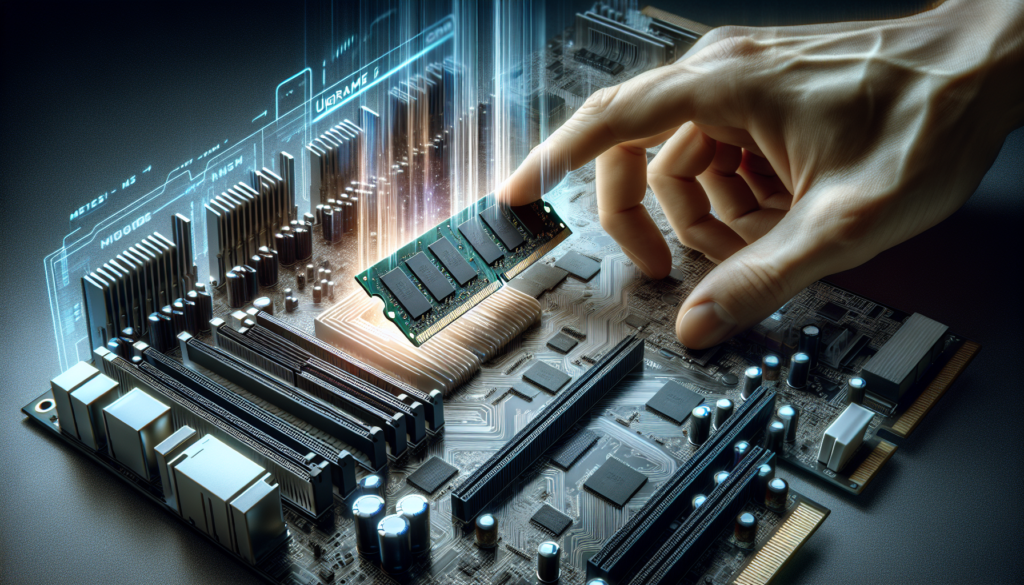If you’ve ever wondered about the steps involved in upgrading the RAM on your computer and the benefits it can bring, look no further. This article dives into the easy-to-follow process of upgrading your RAM, highlighting the benefits you can expect to see. You’ll discover how increasing your computer’s RAM can improve its performance, boost multitasking capabilities, and enhance overall productivity. So, whether you’re a tech-savvy enthusiast or just looking to give your computer a little boost, read on to learn all about upgrading your RAM and the exciting benefits that await you.

This image is property of images.pexels.com.
Determining the Need for RAM Upgrade
Checking the current RAM capacity
Before deciding to upgrade your RAM, it is essential to check the current capacity of your computer’s memory. This can be done by accessing the system information or task manager on your operating system. Knowing how much RAM is currently installed will help you determine if an upgrade is necessary.
Identifying performance issues
One of the main reasons to consider a RAM upgrade is if you are experiencing performance issues with your computer. If your system is running slow, applications are taking longer to load, or you notice frequent lag or freezing, it could be a sign that your current RAM is insufficient. Upgrading the RAM can significantly improve system responsiveness and overall performance.
Considering software requirements
Another factor to consider when determining the need for a RAM upgrade is the software you use on your computer. Some resource-intensive applications, such as video editing software or virtual machines, require a significant amount of RAM to function optimally. If you frequently use these applications, it is advisable to upgrade your RAM to meet their specific requirements.
Understanding RAM
Definition of RAM
RAM stands for Random Access Memory, and it is a type of computer memory that allows data to be read from and written to by the computer’s processor. Unlike permanent storage devices like hard drives or solid-state drives (SSDs), RAM is volatile, meaning its content is lost when the computer is powered off. RAM plays a crucial role in determining the speed and efficiency of your computer.
Role of RAM in computer performance
RAM is responsible for storing and quickly accessing data for the computer’s operating system and running applications. When you open a program, the required data is loaded into RAM for easy access by the processor. The more RAM your computer has, the more data it can store and access simultaneously, which results in smoother and faster performance. In essence, RAM acts as a temporary workspace for your computer to efficiently process tasks.
Different types of RAM
There are various types of RAM available, including DDR3, DDR4, and DDR5, each with its own specifications. DDR3 RAM is widely used in older systems, while DDR4 is more common in newer computers. DDR5 is the latest technology and offers faster speeds and improved performance compared to its predecessors. It’s important to check your computer’s motherboard compatibility to determine which type of RAM is compatible with your system.
Researching Compatible RAM
Checking the motherboard specifications
Before purchasing new RAM modules, it is crucial to check the specifications of your computer’s motherboard. The motherboard determines what type of RAM is compatible with your system and the maximum RAM capacity it can support. Refer to your motherboard’s documentation or visit the manufacturer’s website for detailed information about RAM compatibility.
Identifying RAM type and speed
Once you have determined the compatibility of your motherboard, you need to identify the type and speed of RAM that your system requires. This information can be found in the motherboard specifications or by referring to the RAM currently installed in your computer. It is essential to match the type and speed of RAM to ensure optimal performance and compatibility.
Determining maximum RAM capacity
The maximum RAM capacity is another important factor to consider when upgrading your computer’s memory. It determines the highest amount of RAM that your motherboard can support. This information can usually be found in the motherboard specifications. It is advisable to upgrade to the maximum supported capacity to maximize the benefits of the RAM upgrade.
Preparing for the RAM Upgrade
Backing up important data
Before proceeding with any hardware upgrades, it is crucial to back up all important data on your computer. This ensures that your files and documents are safely preserved in case of any unforeseen issues during the RAM upgrade process. You can create a backup by copying your files to an external hard drive, using cloud storage, or utilizing backup software.
Shutting down and disconnecting the computer
To begin the RAM upgrade process, you must shut down your computer and disconnect all cables and peripherals. This includes unplugging the power cord, disconnecting any external devices, and removing the battery (if applicable). It is important to take this step to prevent any electrical discharge or damage to the computer components.
Taking necessary precautions
When working with computer hardware, it is essential to take necessary precautions to avoid damage or injury. Ensure that you are working in a clean and static-free environment, as static electricity can damage delicate components. Consider wearing an anti-static wristband or regularly grounding yourself by touching a grounded metal object. Additionally, handle the RAM modules with care, avoiding excessive force or bending.

This image is property of images.pexels.com.
Opening the Computer Case
Locating the computer case screws
Before opening the computer case, you need to locate the screws that hold it together. These screws are typically located at the back of the case. Depending on the case model, there may be thumb screws or standard Phillips head screws that need to be removed to access the internal components. Once all screws are identified, keep them in a safe place for reassembly later.
Removing the computer case cover
Once the screws are removed, carefully slide or lift off the computer case cover. Some cases may have latches or buttons that need to be released to open the case. Pay attention to any cables or connectors that may be attached to the cover, ensuring that they are safely disconnected before fully removing the cover.
Understanding the internal components
After opening the computer case, take a moment to familiarize yourself with the internal components. These components include the motherboard, processor, graphics card, power supply unit (PSU), storage drives, and, most importantly, the RAM modules. Identify the slots where the RAM modules are inserted, typically located near the CPU socket.
Removing Existing RAM Modules
Identifying the existing RAM modules
To remove the existing RAM modules, you need to identify them within the computer. Most motherboards have multiple RAM slots, and the existing modules may be installed in some of these slots. Each module will be placed in its slot and secured by retention clips on either side. Take note of the slot number and any specifications labeled on the existing modules.
Releasing the module retention clips
To remove the RAM modules, the retention clips on either side of the module need to be released. Gently push the clips outward until they release the module. Some clips may automatically spring back, while others may need to be held in the outward position.
Carefully removing the RAM modules
Once the module retention clips are released, carefully pull the RAM modules straight out of their slots. Do not apply excessive force or twist the modules, as this can cause damage to the RAM or motherboard. Place the removed modules in an anti-static bag or on an anti-static surface to prevent any electrostatic discharge.

This image is property of images.pexels.com.
Installing the New RAM Modules
Matching the new RAM modules with sockets
Before installing the new RAM modules, ensure that they match the type and specifications of your motherboard. Check that each module corresponds to the requirements identified earlier, including the appropriate capacity, type, and speed. Match the notch on the RAM module with the key in the RAM slot to ensure proper alignment.
Inserting the RAM modules correctly
To install the new RAM modules, align the notch on the module with the key in the RAM slot. Hold the module by its edges and gently press it into the slot until the retention clips on both sides automatically secure the module. Apply even pressure to ensure the module is fully inserted, but avoid using excessive force.
Securing the module retention clips
Once the RAM module is inserted correctly, the retention clips should automatically secure it in place. Double-check that the retention clips are fully engaged with the module, ensuring a snug fit. This will prevent the RAM module from dislodging during use.
Closing the Computer Case
Ensuring all components are back in place
After installing the new RAM modules, ensure that all other components within the computer case are correctly positioned. Check the connections of cables, particularly those attached to the motherboard, storage drives, and power supply unit. Verify that any expansion cards, such as graphics cards, are securely in their slots.
Aligning and fastening the case cover
To close the computer case, position the cover back onto the case. Align the cover with the corresponding screw holes and gently slide or press it into place. Make sure all edges are flush with the case. Once aligned, reinsert the screws removed earlier, being careful not to overtighten them.
Double-checking the case screws
Before finalizing the case closure, double-check that all screws are securely fastened. Ensure that each screw is tightened but not overly tight, as this can damage the case or strip the screw holes. The case should feel stable and firmly closed.
Powering on the Computer
Reconnecting all cables and peripherals
After closing the computer case, you need to reconnect all cables and peripherals that were previously disconnected. This includes connecting the power cord, keyboard, mouse, monitor, speakers, and any other devices. Double-check that all connections are secure and properly inserted.
Turning on the computer
Once all cables and peripherals are connected, you can proceed to turn on the computer. Press the power button, and the computer should begin to boot up. On startup, the system may automatically detect the new RAM modules and adjust the settings accordingly. If prompted, follow any on-screen instructions specific to your motherboard or operating system.
Verifying the new RAM installation
After the computer has booted up, you can verify the successful installation of the new RAM modules. Access the system information or task manager on your operating system and check the RAM capacity. It should reflect the upgraded amount of RAM. Additionally, you can open resource-intensive applications to observe any performance improvements due to the increased memory.
Benefits of Upgrading RAM
Improved multitasking capabilities
One of the primary benefits of upgrading your RAM is improved multitasking capabilities. With more RAM, your computer can handle multiple applications and tasks simultaneously without significant performance degradation. This means you can efficiently run multiple programs, browse the web, or edit documents without experiencing slowdowns or freezing.
Enhanced system responsiveness
Upgrading your RAM can significantly enhance the overall responsiveness of your system. With more memory available, applications load faster, and the operating system can respond swiftly to your commands. This results in a smoother user experience, where you spend less time waiting for programs to open or files to save.
Faster program loading times
RAM plays a crucial role in loading and storing data for running programs. By upgrading your RAM, you can expect faster program loading times, as more data can be stored in memory for quick access. This is particularly beneficial for resource-intensive applications, such as video editing software or virtual machines, which often require large amounts of memory.
Increased overall system performance
Perhaps the most significant benefit of upgrading your RAM is the overall increase in system performance. With more memory available, your computer can efficiently process data, leading to faster execution of tasks and improved performance across the board. Whether you’re gaming, editing videos, or simply browsing the web, upgrading your RAM can provide a noticeable boost in speed and responsiveness.


